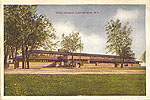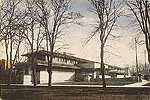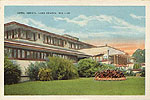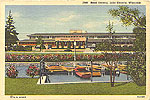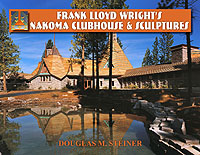|
Not much has
been written about the Lake Geneva Hotel. Lake Geneva
was a popular destination attracting visitors from both
Chicago and Milwaukee. One of the few hotels in Lake Geneva,
The Whiting House, built in the early
1870s was destroyed by fire in1894. The lake front
property sat vacant for 17 years while attempts were made to
reconstruct a new motel. This was finally accomplished
by Arthur L. Richards and John J. Williams.
Arthur L. Richards was a real estate
developer in Milwaukee, WI. He is well known for his
association with Wright and the development of the American
System-Built Homes (S.200 - 204) (1915-1917). These
homes are still being discovered today. John J. Williams was
a businessman from Chicago. Richards and Williams
formed the Artistic Building Company and developed the Lake
Geneva Hotel. This was Richards first project with
Wright. Designed in 1911 as "The Geneva Inn", "The Geneva"
opened in August 1912. Within two years, it changed hands
due to financial difficulties. By the end of 1914 and the
beginning of 1915 the name was changed to the Hotel Geneva,
and it stayed the Hotel Geneva most of its life. During its
final years it was known as "The Geneva Inn".
In 1917, the
Hotel Geneva was
advertised
as "New and Modern. 70 Rooms with Bath. Dancing, Swimming
and Fishing. Fish or Chicken dinners. 9 Hole Golf Course
Open to the Public. A. H. Thierbach, E. T. Nussbaum Owners."
John K. Notz, Jr. writes that
“in the 1920's, the Lake Geneva hotel was in its hey-day. It
is said that, during the Prohibition that started in 1919
and lasted into the early 1930's, tunnels into the basements
of nearby storefront buildings facilitated the movement of
booze for consumption into the hotel and, when raids for
Prohibition violations or gambling took place, the movement
of customers out. While there are denials of that kind of
activity in the local written histories such as the now
defunct "Lake Geneva Magazine", such activities are more
than plausible, as I have been told of biplane landings in
the Winter on the frozen lake surface, for the purpose of
picking up "booze" from the lake shore residences.
"A long-time operator-owner sold it,
vacant, in 1962 but
|
|
took it back in 1965. Selling it, again, in 1966. Eric
Johnson of Williams Bay, WI - then an architectural student
- spent a Summer vacation measuring, cataloguing and
sketching all of the hotel's panels, bricks and window
sills."
A set of images by
Richard Nickel dated July 1967, shows that the restaurant had been operated as
the Golden Orchid, Cantonese American Cuisine. But The Milwaukee
Journal, Sept 1, 1967 reported that a tavern named the
Geneva Inn belonged to George Borg, but mentions nothing
about the hotel. (More)
Richard Nickel also captioned
image #3 as
the Dining Room. This may be due to the assumed use at the
time this photograph was taken. As you can see from the
image, this area was converted to a dining area. In
Monograph V3 p189, Pfeiffer, and in
Lost Wright p119 Lind,
both describe this area as the Dining Room. This can
not be the Dining Room, but the Lobby. The Lobby is the only
room that has a row of lower windows. The original drawings
indicate columns in the middle of the Dining Room. The
drawings also indicate a square in the center of the Lobby
area in relationship to the placement of the skylight.
Wright’s other collaborations with Richards
included: Remodeling of the Hotel Madison, Madison, Project
1911
(V3 p192); Office Building and Shop, Milwaukee, Project
1913 (V3 p236); Chinese Restaurant, Milwaukee, Project 1913
(V3 p237).
There were many classic Prairie styled
Wright details. The basic materials were wood and stucco.
Strong horizontal lines, low-pitched roof, broad overhanging
eaves, horizontal rows upon rows of leaded glass windows,
leaded glass light fixtures and doors, vases, and decorative
poles, the prominent centrally located fireplace and
chimney, terraces and porches. There was a beautiful art
glass skylight ceiling in the lobby. The lobby included
built-in seating, a large semicircular fireplace with a
semicircular metal sculpture and fireplace andirons.
Ownership continued to change over the
years, the building deteriorated, it became vacant and in
January 1970 after a fire, it was demolished.
September 2008 |
